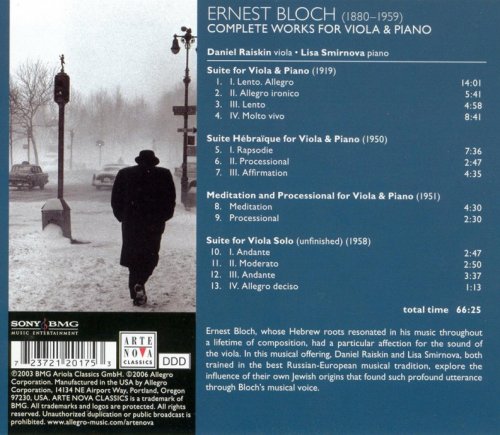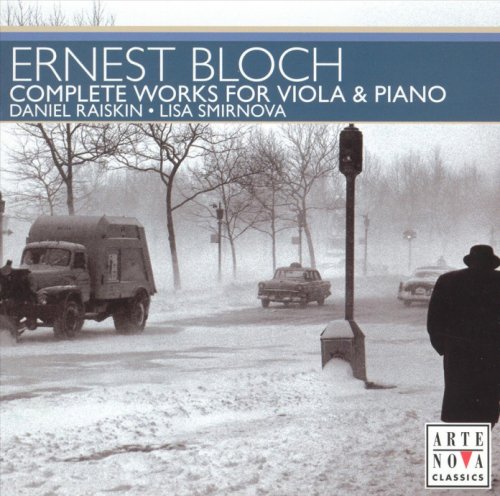
Daniel Raiskin, Lisa Smirnova - Bloch: Complete Works for Viola & Piano (2006)
BAND/ARTIST: Daniel Raiskin, Lisa Smirnova
- Title: Bloch: Complete Works for Viola & Piano
- Year Of Release: 2006
- Label: Arte Nova Classics
- Genre: Classical
- Quality: FLAC (image+.cue,log,scans)
- Total Time: 01:06:22
- Total Size: 289 MB
- WebSite: Album Preview
Tracklist:
01. Suite for Viola & Piano (1919): I. Lento. Allegro (14:05)
02. Suite for Viola & Piano (1919): II. Allegro ironico (5:45)
03. Suite for Viola & Piano (1919): III. Lento (5:04)
04. Suite for Viola & Piano (1919): IV. Molto vivo (8:47)
05. Suite Hébraïque for Viola & Piano (1950): I. Rapsodie (7:36)
06. Suite Hébraïque for Viola & Piano (1950): II. Processional (2:50)
07. Suite Hébraïque for Viola & Piano (1950): III. Affirmation (4:40)
08. Meditation and Processional for Viola & Piano (1951): Meditation (4:33)
09. Meditation and Processional for Viola & Piano (1951): Processional (2:36)
10. Suite for Viola Solo (unfinished, 1958): I. Andante (2:47)
11. Suite for Viola Solo (unfinished, 1958): II. Moderato (2:50)
12. Suite for Viola Solo (unfinished, 1958): III. Andante (3:37)
13. Suite for Viola Solo (unfinished, 1958): IV. Allegro deciso (1:13)

01. Suite for Viola & Piano (1919): I. Lento. Allegro (14:05)
02. Suite for Viola & Piano (1919): II. Allegro ironico (5:45)
03. Suite for Viola & Piano (1919): III. Lento (5:04)
04. Suite for Viola & Piano (1919): IV. Molto vivo (8:47)
05. Suite Hébraïque for Viola & Piano (1950): I. Rapsodie (7:36)
06. Suite Hébraïque for Viola & Piano (1950): II. Processional (2:50)
07. Suite Hébraïque for Viola & Piano (1950): III. Affirmation (4:40)
08. Meditation and Processional for Viola & Piano (1951): Meditation (4:33)
09. Meditation and Processional for Viola & Piano (1951): Processional (2:36)
10. Suite for Viola Solo (unfinished, 1958): I. Andante (2:47)
11. Suite for Viola Solo (unfinished, 1958): II. Moderato (2:50)
12. Suite for Viola Solo (unfinished, 1958): III. Andante (3:37)
13. Suite for Viola Solo (unfinished, 1958): IV. Allegro deciso (1:13)
Ernest Bloch (1880-1959) was born in Switzerland, into a religious Jewish family, and throughout his life retained a keen interest in the study of the Jewish part of the Bible and musical traditions of folklore and worship. There are many quotes where he speaks of himself as a Jewish composer.
He received a musical education in composition and violin in several European countries. In 1916 he moved to the USA, where he immediately began a successful career as an orchestra leader and as a composer.
Suite for Viola & Piano (1919) was first performed at one of the American music festivals and became decisive in terms of recognition of the composer's talent.
Suite Hébraïque for Viola & Piano (1950) – the work is supposed to resemble holding a religious service in a synagogue. The first part – Rapsodie – is in the spirit of the Nigun part (song) from Baal Shem Suit (1923) – an improvisation on the theme of the cantor's passionate performance of prayer in the synagogue. Next comes the Processional, i.e. the hymn song, already performed collectively by the whole community, is restrained and strict in form. The last part of the Affirmation is the logical conclusion of the divine service.
Meditation and Procedural for Viola & Piano (1951) is a work close in spirit to the previous one.
Suite for Viola Solo (Unfinished, 1958) is the composer's last work, unfinished due to his illness and death. It is symbolic in many ways. For example, the fact that the first, which became a springboard for world fame, was also Suite for Viola, only here viola performs solo, as a "naked" musical thought, not embellished with the texture of the accompaniment; clever brevity, conciseness and consistency of the story, leaving no room for empty words. A quick look at both the illustrious past and the future (an attempt to link together the Baroque form, the pathos of Bach and the technique of dodecaphony). Even the "finale" of the unfinished suite is symbolic: like an interrupted flight of a soaring thought, like an outburst of emotions, like a broken climax – life ends with music.
He received a musical education in composition and violin in several European countries. In 1916 he moved to the USA, where he immediately began a successful career as an orchestra leader and as a composer.
Suite for Viola & Piano (1919) was first performed at one of the American music festivals and became decisive in terms of recognition of the composer's talent.
Suite Hébraïque for Viola & Piano (1950) – the work is supposed to resemble holding a religious service in a synagogue. The first part – Rapsodie – is in the spirit of the Nigun part (song) from Baal Shem Suit (1923) – an improvisation on the theme of the cantor's passionate performance of prayer in the synagogue. Next comes the Processional, i.e. the hymn song, already performed collectively by the whole community, is restrained and strict in form. The last part of the Affirmation is the logical conclusion of the divine service.
Meditation and Procedural for Viola & Piano (1951) is a work close in spirit to the previous one.
Suite for Viola Solo (Unfinished, 1958) is the composer's last work, unfinished due to his illness and death. It is symbolic in many ways. For example, the fact that the first, which became a springboard for world fame, was also Suite for Viola, only here viola performs solo, as a "naked" musical thought, not embellished with the texture of the accompaniment; clever brevity, conciseness and consistency of the story, leaving no room for empty words. A quick look at both the illustrious past and the future (an attempt to link together the Baroque form, the pathos of Bach and the technique of dodecaphony). Even the "finale" of the unfinished suite is symbolic: like an interrupted flight of a soaring thought, like an outburst of emotions, like a broken climax – life ends with music.

Download Link Isra.Cloud
Daniel Raiskin, Lisa Smirnova - Bloch: Complete Works for Viola & Piano (2006)
My blog
Daniel Raiskin, Lisa Smirnova - Bloch: Complete Works for Viola & Piano (2006)
My blog
Classical | FLAC / APE | CD-Rip
As a ISRA.CLOUD's PREMIUM member you will have the following benefits:
- Unlimited high speed downloads
- Download directly without waiting time
- Unlimited parallel downloads
- Support for download accelerators
- No advertising
- Resume broken downloads


